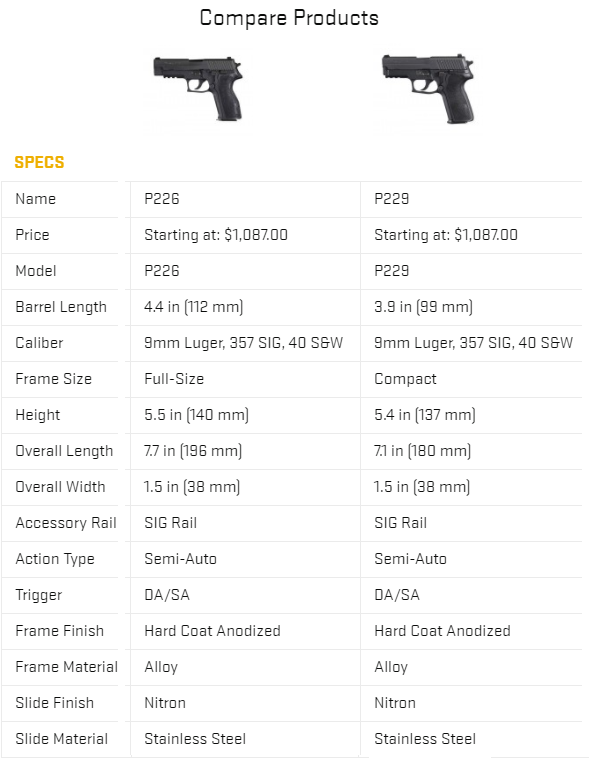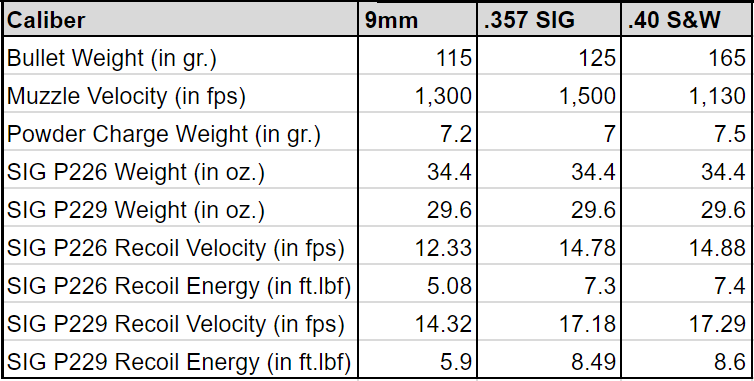Between Sig Sauer's P226 and P229, Which Gun Comes Out On Top?
We go all-in on the details.
What would you choose?
In the first four rounds of our Handgun Showdown series, we’ve been comparing different Glock pistols, then in round 5 we compared two Saturday Night Specials both manufactured by Cobra Enterprises.
Today we’re taking a look at two SIG Sauer pistols: the full-size SIG P226 and the compact SIG P229, both modular pistols that can be chambered for the same three handgun calibers 9mm, .357 SIG and .40 S&W and popular among law enforcement officers, the military and civilians.
THE TALE OF THE TAPE


If by looking at the tables above you think to yourself that there’s not much difference between the P226 and the P229, you are probably correct.
Both have practically the same frame dimensions, the same exact magazine capacity, the same frame and slide material, the same SA/DA trigger pull weight, and the same number of rifling grooves and rifling length of twist. Even the calibers they can use are the same.
And they both have the same accessory rail for laser and flash light attachments.
The only real differences between them are their barrel, slide and sight radius lengths. So what gives?
HERE WE GO AGAIN…
If you haven’t been following our series of handgun showdowns, you might want to. In round 1, we discussed the differences between the Glock 22 and the Glock 23. Both are practically the same pistols chambered for the .40 S&W. The only things different between them are their barrel and slide lengths and their magazine capacity.
Well, for this round, both SIG Sauer pistols being compared have the same magazine capacity despite one being a tad smaller than the other. But both pistols can be bought chambered in one of three different handgun calibers: 9mm, .357 SIG and .40 S&W. That’s what’s so different this time.
WHEN DOES SIZE MATTER?
Let’s say you’re a first time buyer, and you’ve read somewhere on the Interwebz that these SIG pistols (particularly the full-size P226) used to be the standard sidearm for the Navy SEALs and you decided you want one (even when you know that for some odd reason, the Navy SEALs replaced them with the Glock 19).
You browse through SIG Sauer’s website and find out that the P226 has a smaller compact brother (technically, “compact” in these contexts is incorrect — it’s supposed to be labeled “mid-size”) called the P229. Now you’re getting confused — which one would you buy if both are practically the same pistols, both have the same round count and both are priced the same?
We all know that a handgun with longer slide and a longer barrel will have a relatively softer recoil, and better recoil control will result to faster re-acquisition of sights and faster follow-up shots. A longer sight radius will also result in more accurate shots.
But we also know that a shorter grip won’t print easily, so guns with shorter grips will be easier to carry concealed.
So it looks like the P226 has two things going for it, while the P229 only has one. Does this mean the P226 is going to be the better option? Let’s find out.
HANDGUN CALIBERS AND RECOIL
Just so you’ll have an easier time deciding, let’s see how having a longer slide and barrel and more weight will favor the P226 as far as recoil control in all of the three handgun calibers it will chamber.
When a hammer-fired semi-automatic handgun’s trigger is pulled, the spring-loaded hammer is released by the trigger’s sear to hit the firing pin which strikes the chambered cartridge’s primer. The primer then ignites the powder charge in the cartridge.
The powder burns quickly, creating an astronomically high amount of pressure (take note of this part) which results in the bullet being pushed out the only available direction — towards the muzzle.
As the bullet is pushed out of the cartridge and out of the muzzle, it pushes the slide in the opposite direction — towards the person holding the gun (take note of this part too). The slide absorbs some of the force of recoil by ejecting the empty cartridge and re-cocking the hammer.
The recoil spring won’t let the slide rest in its rearward position so it pushes the slide forward (or it pulls it back to its original position, whichever way you want to look at it), and on its way to full battery the slide snags a fresh cartridge protruding from the lip of the magazine and pushes it into the chamber, thus completing the whole cycle. The handgun is then ready for another shot.
This astronomically high amount of pressure varies across different handgun calibers. This pressure sets four things in motion at the same time (but because our human senses can only perceive too many things happening at once, we see it in this sequence):
-
It pushes the bullet out of the muzzle, and the bullet will hit whatever’s in front of it, for better or for worse.
-
It pushes the slide rearward so it can do its job — eject the spent case and re-cock the hammer (thereby indirectly putting tension to the main spring).
-
By pushing the slide rearward, it indirectly loads the recoil spring with energy. Springs by design don’t want to be bothered by any external forces acting upon them so they will always try to revert to their original state. The spring releases the energy, pushing the slide forward, and in the process the slide loads the chamber with another round.
-
The remaining force from the pressure pushes the frame and grip of the handgun towards the hands of the person who pulled the trigger — this is what’s known as recoil.
Because this pressure varies depending on a few things, let’s look at how each of the handgun calibers would recoil when fired from either handgun.

From the table above, we can see that a bullet’s weight and velocity and the powder charge used are all directly proportional to both recoil. The heavier a bullet and the more powder charge used to send it flying at higher velocities, the more the gun recoils.
We can also see that the weight of a firearm is inversely proportional to recoil. The heavier a gun is, the less it recoils.
For all the people out there who have trouble with Physics or Math, I created some charts to better illustrate these points.
RECOIL VELOCITY

Light blue bar: SIG P226 recoil velocity in fps; dark blue bar: SIG P229 recoil velocity in fps. Lower is better.
Imagine being able to fire a gun without even holding it and without your index finger pulling the trigger. The force of the recoil from shooting the 9mm will send the SIG P226 flying 12.33 feet in a second. The same force will send the SIG P229 flying 14.32 feet in a second. That’s a ~13.8% difference in recoil velocity between the two.
Doing the same math for .357 SIG, the force of the recoil from shooting the .357 SIG will send the SIG P226 flying 14.78 feet in a second, and the same force will send the SIG P229 flying 17.18 feet in a second, a ~13.9% difference in recoil velocity between the two pistols.
For .40 S&W, the force of the recoil from shooting the .40 S&W will send the SIG P226 flying 14.88 feet in a second, and the same force will send the SIG P229 flying 17.29 feet in a second, again a ~13.9% difference in recoil velocity.
The consistent ~13.9% recoil velocity difference between the SIG P226 and SIG P229 is relatively low when comparing recoil velocities from the same handgun caliber. What this means is the difference in recoil velocity between the two handguns is negligible assuming both are chambered for the same caliber (unless you’re really having trouble aiming after a follow up shot).
Let’s do things a little differently. We’ll not be including the .357 SIG this time because its recoil velocities are pretty much the same as the .40 S&W’s.
If we compare recoil velocities between a SIG P229 chambered for the .40 S&W (17.29 fps) and the same SIG P229 chambered for the 9mm (14.32 fps), the difference is ~17.17% in recoil velocity. This means there won’t be much difference in accuracy and sight re-acquisition when shooting any of the three handgun calibers using the same mid-size pistol.
What if we compare the recoil velocity between a SIG P226 chambered for the 9mm and a SIG P229 chambered for the .40 S&W? We get a difference of ~28.68% in recoil velocities. This means if you’re comfortable shooting a full-size 9mm pistol and you decided to try a mid-size .40 S&W, you might find it harder to shoot the mid-size pistol as fast and as accurate. We’ll get more into this later.
RECOIL ENERGY
Recoil energy is different from recoil velocity.
To spare everyone all the headache from trying to make sense of it, I view recoil velocity as how fast the gun would move upon recoil when fired from an open space(like if it was hanging in the air and it wouldn’t be affected by any type of friction), while I view recoil energy as that force I feel in my hands whenever I fire a gun. Simply put, recoil energy to me is what other people call “felt recoil”.

